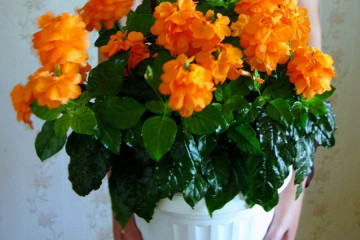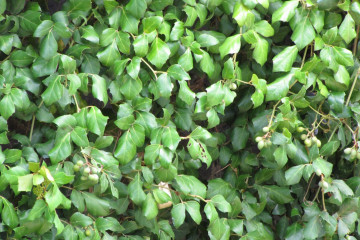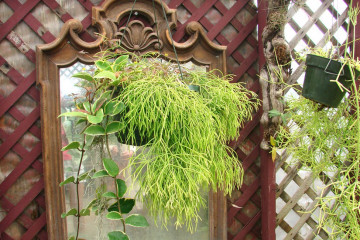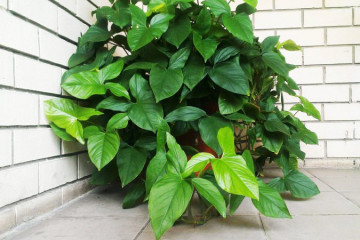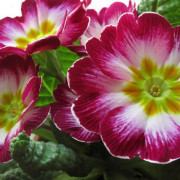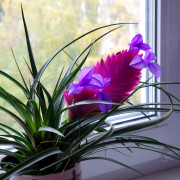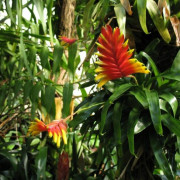Bromeliad - home care, watering and reproduction
Content:
Among indoor plants, there are close relatives of tropical fruits. One such representative is the pineapple-like bromeliad. This is the general name for epiphytes that grow in tropical conditions on the bark of other trees, although they are not parasitic species. The family includes about 50 plant species. The article below describes how to organize bromeliad care, taking into account the need for high humidity and maintaining temperature.
How to choose a healthy plant in the store
Determining that the plant you are buying is healthy is not difficult. The green fleshy leaves form a rosette. Some species have a pronounced marble pattern on the surface. Bromeliads have no trunk, the peduncle rises above the rest, it is always bright in color.
Based on the ideas about the appearance of a healthy plant, it becomes clear: the presence of spots, plaque on the leaves, their softening guarantee that the flower is sick.
Bromelia: home care
Bromeliad houseplants have an impressive ground part, but a weak root system. Therefore, they do not need a large transplant pot. There are requirements for the quality and composition of the soil, as well as the irrigation regime.
Some growers recommend replanting the plant immediately after purchase in order to examine the root system for diseases and pests. The main part of experts insists that the flower must adapt to new conditions for several weeks. After that, you need to move the sprout to a new pot of suitable volume.
Choosing a soil for bromeliads
Soil for bromeliads should be loose, light, airy. For this, crushed bark of coniferous trees, coal are added to it. The soil should be low in acidity. The optimal composition of the substrate should be as follows:
- 40% leaf humus;
- 20% sand;
- 20% peat;
- 20% of the land with humus.
A drainage layer of porous pebbles or broken fragments of earthenware is placed on the bottom of the pot.
How to water
Plants of the Bromelia family require proper home care. The first priority is to ensure proper watering. Epiphytes take the necessary moisture from the surrounding space, and also absorb it through the surface of the leaf and the rosette. Therefore, it is necessary to water correctly by filling the central part with water. It should be warm after standing. It is best to take filtered or distilled. Additionally, you can also spray the pot with a spray bottle.
Bromeliad has faded, what to do next
Bromelia is a flower that releases a receptacle only once in a lifetime. After a long active period, the mother plant dies.Therefore, an incomprehensible situation arises when the bromeliad has faded: what to do next?
If the epiphyte is kept in comfortable conditions, up to this point it releases lateral shoots, which can subsequently be planted. To create suitable conditions for the growing season, you need to cut it off at the outlet even before the flower dries. This stimulates the growth of daughter processes.
Reproduction at home
The bromeliad slipper flower reproduces by germinating shoots that form around the main individual. The parameter of readiness for separation is the height of the shoot half the growth of the main one.
After the active period, you need to separate the new shoot with a sharp knife, place it in a nutritious substrate consisting of a mixture of peat and sand. The containers are covered with glass or polyethylene. Sprouts need to be kept at a high temperature of 26-28 ° C, as well as a constant source of light and humidity.
Bromeliad can also propagate by seed, but this is a more complicated method. In the store, they buy ready-made hybrid varieties in a bag, soak them in a solution of potassium permanganate and dry them. Next, the material is placed in a nutrient substrate, creating optimal conditions. After germination, a sprout of several centimeters is expected, which happens in 2-3 months. After six months, the plant is transplanted into a larger pot.
How to care for bromeliad mix
This is the common name for the entire family. In flower shops you can see pots of different appearance, having the same name bromeliad mix. This includes Guzmania, Tilandsia, Ehmeya, Neoregelia, etc. All varieties have the same requirements for watering and maintenance.
Bromeliad flower mix: home care
Like all tropical plants, bromeliad mixes require high humidity and temperature. Knowing how to care for them, you can get several generations of children, which will allow you to constantly grow flowers at home.
Watering, Daily Care and Moisture Regimen
Watering the plant is necessary as the substrate dries. Stagnation of water in the sump should be avoided. A container of liquid should be placed next to the pot so that the bromeliad can receive the required amount of moisture. In summer, periodically you need to wipe the leaves with a cloth, preventing them from becoming dusty. Once every 2 weeks, the water from the outlet is drained and replaced with a new one.
Diseases, pests and methods of dealing with them
Looking at the plant, you can see signs of illness and the presence of parasites:
- dried edge of leaves;
- spots on the surface;
- cessation of growth and softening of leaves;
- the surface of the appendix becomes dark.
When the vegetative part of bromeliads dries up, liquid deficiency should be excluded. As a rule, there is no water in the outlet, the soil is dry. If the shoot has darkened and become evenly dark green, this indicates the content of the pot in a low temperature environment. The termination of the growth of shoots indicates an excess of moisture.
In addition, pests attack bromeliads. More often than others, spider mites, thrips, scale insects. The first can be recognized by the appearance of cobwebs or small white dots on the inside of the leaf.
Thrips are small insects that grow on the inside of the sprout. If left untreated, the leaf dies off. Scabbards are small insects, like scales, covering the surface.
Fertilizers and feeding
Only the mineral option is suitable for fertilizing the plant. The frequency of feeding is once every 3-4 weeks during the flowering period, less often in winter. The concentration should be 2 times lower than indicated in the instructions.
Bromelia Moora
The plant is distinguished by lanceolate leaves 22-25 cm long, up to 5 cm wide.There are thorns along the edges, in the center the surface is bronze-green, which smoothly turns into a reddish color. The inflorescence is spike-shaped and yellow in color.
How to water, humidity
Watering conditions do not differ from other representatives of bromeliads.
Optimum temperature
The optimum temperature for a plant that is going to bloom is 24-25 ° C. When the buds bloom, it is lowered to 20 ° C.
Location and lighting
There should be a lot of light in the place where the flowerpot stands, but direct rays should not hit the surface. Bromeliads will be most comfortable on the windowsill on the west or east side.
Plant substrate
A young plant requires a rich substrate of several types of humus. After a couple of years, the soil mixture can be changed to acidic.
Thus, bromeliad is a collective concept of a whole family of plants growing in South America. Only some types are suitable for decorative use. Due to its wild relatives, the plant loves high humidity, temperature and ambient light. Different species differ in length, height, color of leaves, but the principle of cultivation is the same.





